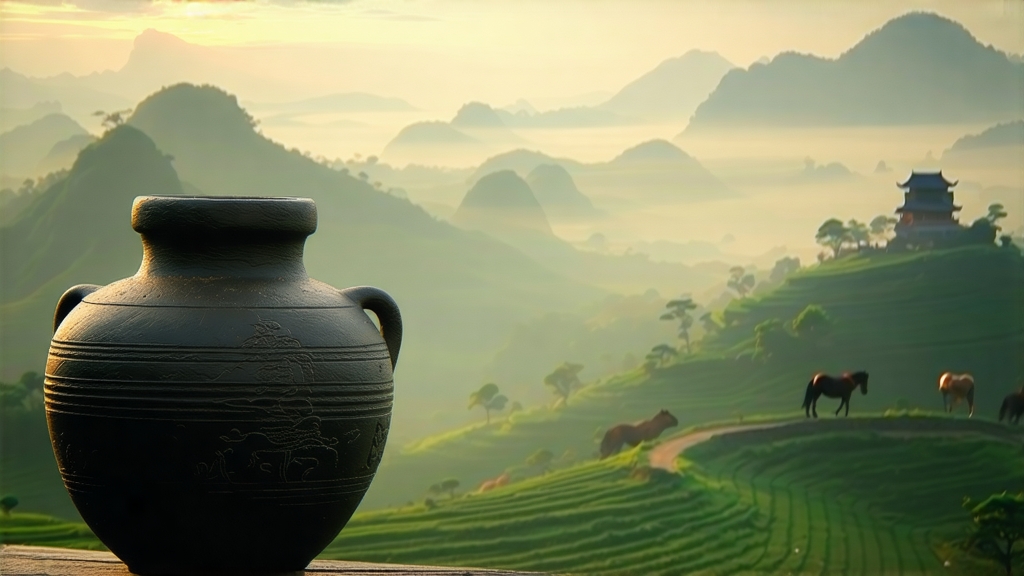
Liu Bao, literally “Six Forts,” is the name of a dark tea that even many Chinese tea lovers have never tasted, yet it once fueled the caravans of the legendary Tea Horse Road and perfumed the holds of nineteenth-century clipper ships bound for Southeast Asia. Produced in the limestone hills of Guangxi Province, this post-fermented tea carries the humid breath of the subtropical forest, the smoke of pinewood drying sheds, and the quiet patience of decades spent in woven bamboo baskets. To drink Liu Bao is to taste history in motion: a tea that was pressed into coarse bricks, strapped to mule saddles, and exchanged for Tibetan horses, yet which—when coaxed with care—reveals a silky liquor reminiscent of cacao, wet orchid, and the lingering sweetness of betel nut.
Historical footprints
The earliest written record appears in the 1799 edition of the Cangwu County Gazetteer, noting that “dark tea from Liu Bao” was bartered for salt and ironware. By the late Qing dynasty the tea had migrated southward with Hakka merchants who established “tea numbering houses” in Wuzhou city. Each house branded its baskets with a secret code of Chinese characters and Arabic numerals; “15018” or “15102” still appear on vintage wrappers today, whispering the genealogy of leaf grade, harvest year, and workshop. When British and Dutch planters searched Yunnan for black-tea clones in the 1930s they overlooked Liu Bao, leaving its microflora untouched and its traditions intact. Thus, while Pu-er became a global buzzword, Liu Bao remained a regional dialect of darkness, spoken fluently only in Guangxi, Malaysia, and the dim sum parlors of Hong Kong where it is still consumed to cut through the grease of har gow.
Micro-terroirs within one county
Although the name refers to six historic fortresses, the tea is now crafted across the entire county of Cangwu, stretching from the mist-laden foothills of the Daqing Shan to the alluvial plains of the Xun River. Gardens above 300 m yield leaves high in polyphenols, ideal for the long microbial journey ahead; lower elevations produce softer leaf that darkens quickly but lacks the stamina for twenty-year aging. The most sought-after micro-lot is “Tongping village spring pick,” where red clay soil and nightly mountain fog slow the sprouting, concentrating amino acids that later translate into a honeyed thickness. Farmers speak of “three smells”: the grassy lift of fresh leaf, the fruity funk of sun-wilted leaf, and the deep forest scent that emerges after the first night of piling—an olfactory calendar guiding the hand of the pile master.
Crafting darkness: a choreography of water, heat, and time
Liu Bao belongs to the “wet-pile” family of dark teas, yet its protocol diverges from Yunnan shou Pu-er in decisive details. Fresh leaves are carried in bamboo baskets from garden to shed, where they undergo a brief outdoor withering under the westering sun—no longer than forty minutes—just enough to soften cell walls without oxidizing the green character. The kill-green wok is heated to 280 °C, hotter than that for green tea, scorching leaf edges to create a micro-crust that later traps moisture inside the pile. Rolling is performed in three short bursts—15 min, 10 min, 5 min—allowing the leaf to rest and rehydrate between compressions, a rhythm said to “teach the veins to bend without breaking.”
The pivotal act is piling. A pine-scented floor is swept clean, then sprinkled with the previous year’s already-fermented tea dust to inoculate newcomers. Roughly 500 kg of semi-dry leaf are heaped into a trapezoid one meter high. Jute sacks soaked in river water are draped over the mound like blankets, raising humidity to 65%. Inside this miniature compost the temperature climbs to 55 °C within 24 h; thermophilic bacteria bloom first, followed by yeasts and finally Aspergillus niger, the same species that ripens soybeans into black bean sauce. Every afternoon the pile master inserts a sharpened bamboo pole, withdraws it, and smells the steamy aperture. When the escaping vapor carries the scent of dried longan and wet bark he declares the “first turn,” folding the outer layer inward to equalize moisture and temperature. Seven turns spaced over twenty days reduce the heap by one-third